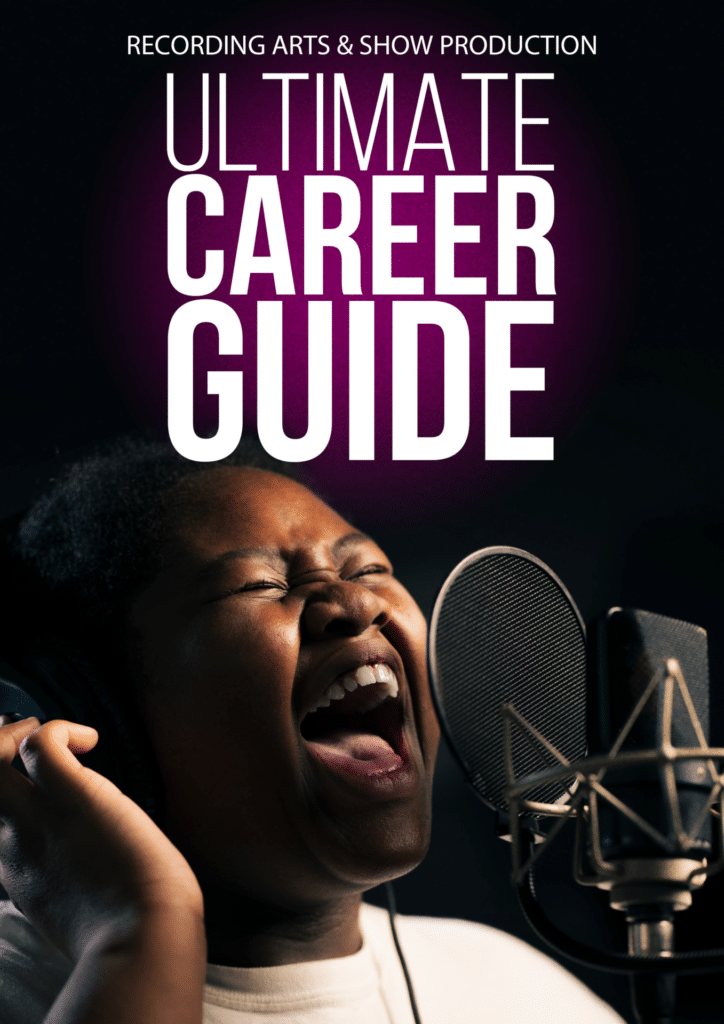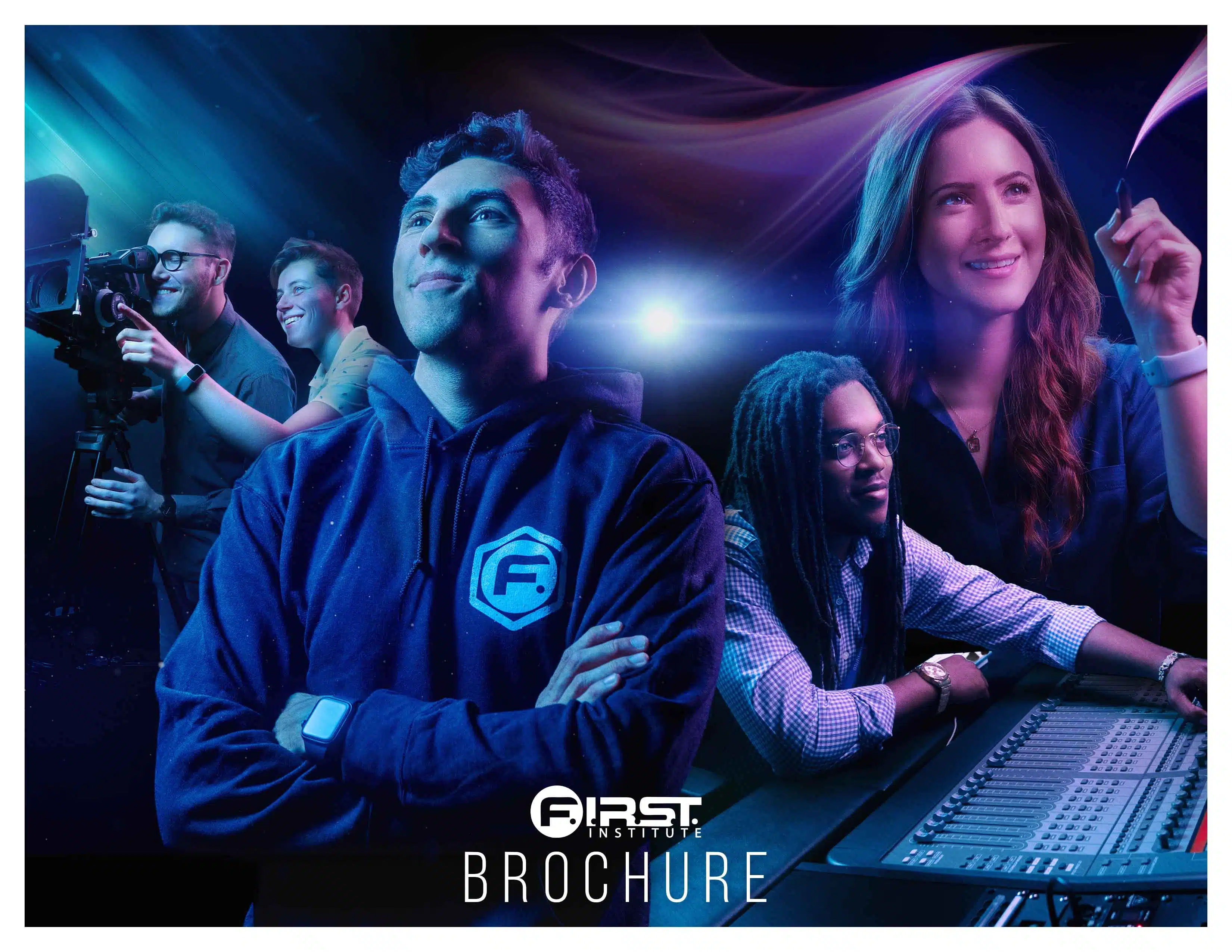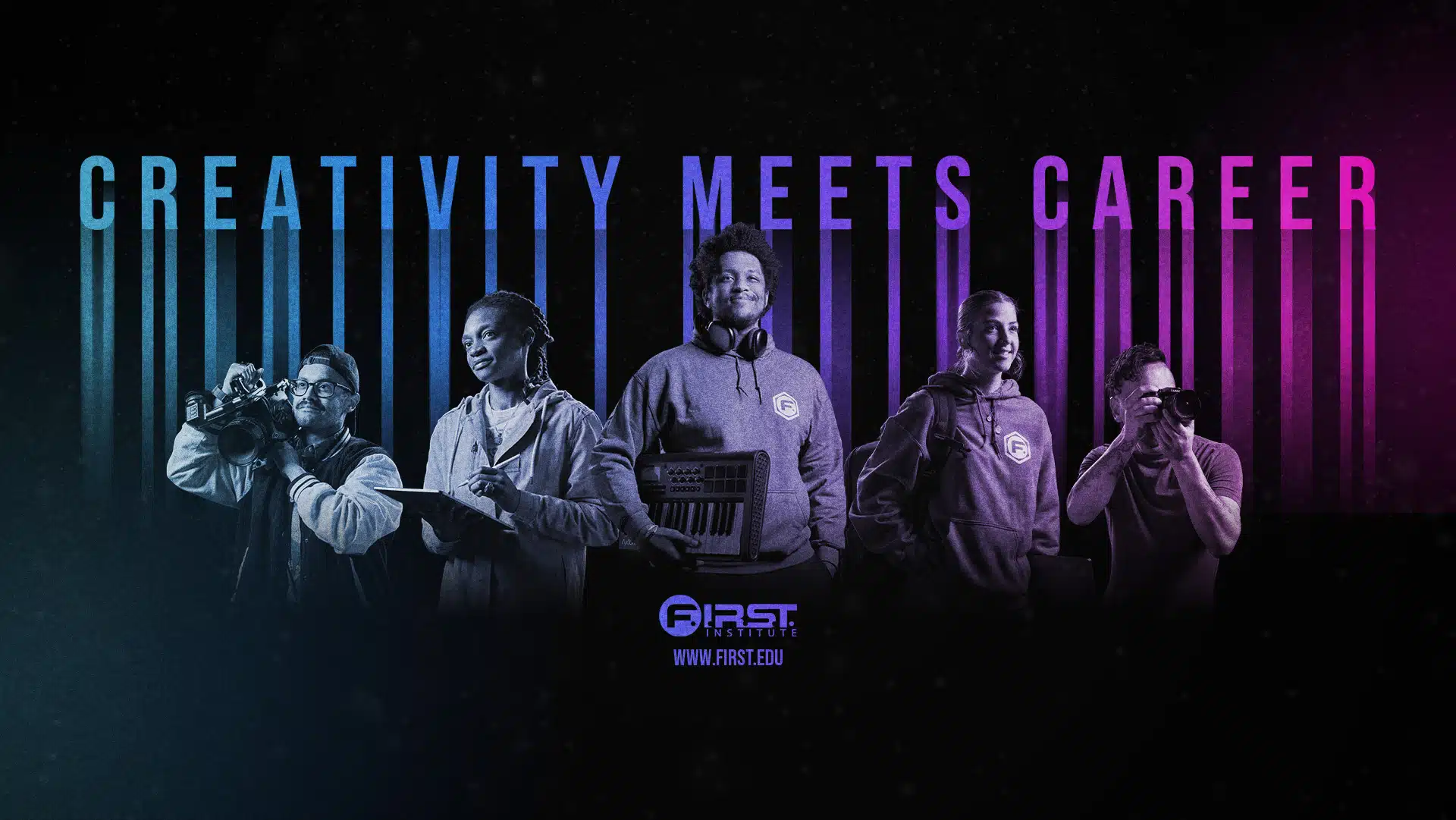PROGRAMS
Recording Arts & Show Production IDL
The Recording Arts and Show Production IDL program is designed to teach students the fundamentals of recording arts and show production, including live sound reinforcement and audio-visual production. Students will receive remote education using up-to-date technology for all types of audio production.
A wide spectrum of professional audio is covered throughout several courses, covering studio, location, installation, and live settings. In each course, students will develop their skills under the mentorship of industry professionals, preparing them for an entry-level position in the audio industry.
Students are graded and held accountable for each course they experience during their instruction at F.I.R.S.T Institute. Consistent exercises, labs, tests, and quizzes keep students engaged in the information presented by the instructors.
Prerequisite: Basic Mac and internet competencies. High school level English or higher.
Delivery Methodology: Interactive Distance Learning (online)
Average Class Size: 15-20 Students
Upon successful completion of the program, graduates obtain a Diploma.
Thirty-Nine (39) Weeks – 1014 Clock Hours / 91.26 Academic Quarter Credit Hours
811 Hours / 81.11 Academic Quarter Credit Hours – Instruction 203 / 10.15 Academic Quarter Credit Hours – Lab
What is Interactive Distance Learning?
Interactive Distance Learning (IDL) is not your typical online education. Students in our IDL programs get the full classroom experience from the comfort of their homes. This is a fully-engaged diploma program that gives students the opportunity to learn hands-on with industry-standard gear and equipment provided in their Creative P.A.K. Each IDL class includes live lectures with instructors, time to work on projects, video conferencing, student-to-student interaction, individual demos, and more.
- Program Name Recording Arts & Show Production - IDL
- Total Clock Hours 1014
- Hours - Instruction 811
- Hours - Lab 203
- Your Creative P.A.K. (included)
- Class Materials (Required)
- RASP 101IDL – Digital Audio Fundamentals
- RASP 102IDL – Music Production
- RASP 103IDL – Recording Arts 101
- RASP 104IDL – Recording Arts 201
- RASP 105IDL – Music Mixing & Mastering
- RASP 106IDL – Sound for Visual Media 101
- RASP 107IDL – Sound For Visual Media 201
- RASP 108IDL – Show Production
Students in our Recording Arts & Show Production program receive a Creative P.A.K. to use during the course of their program and beyond. The digital media industry and its relevant technology are ever-changing, so specific items in your Creative P.A.K. may be updated from time to time.
Gear included in the P.A.K.*
- Avid Pro Tools
- Midi Keyboard – Arturia Keylab Essential mk3 49 key
- USB hub
- Studio One
- Mixer and Recording Kit – Soundcraft notepad mixer, AKG mic and studio kit
- Dynamic mic – Shure SM57 stage kit
- Field Recorder – Tascam Portacapture X6
- Izotope RX 10
- Interface – Solid State Logic SSL 2
- Adapter for mixer – USB 2.0 A to B cable
*Specific items are not guaranteed. Contact the school for more information.
Students are required to be prepared for class. This includes having these items at all times: pen, writing paper/notebook, ID badge, and all required materials for their program. The following required items are not included in the tuition. It is the student’s responsibility to purchase the items for use in their first day of class.
Computer Requirements:
- Operating System: macOS Monterey or above (Ventura or above recommended)
- Processor: Intel or Apple Silicon (Rosetta2 Supported) (M1 or above recommended)
- RAM: 16 GB
- Hard Drive Space: 256 GB with minimum 40 GB available
- GPU VRAM: 2 GB of GPU VRAM
- Monitor Resolution: 1440×900
- Webcam: Yes – used for attendance and exams
- Microphone: Yes – used for class participation
- Click here to view Apple’s education pricing for new computers.
Internet Requirements:
- Broadband or higher from your internet service provider (minimum 100 Mbps) for your computer or any other device to access Canvas materials.
Digital Audio Workstations, or DAWs, are an integral part of the modern audio industry. DAWs are used in all aspects of the audio industry, from the recording studio to live show production. In this course, students will be introduced to DAWs and learn about the many exciting possibilities the audio industry offers.
Learning the basics of computer technology is the foundation for classes enrolled in the program. Students will also learn the principles of sound and the history of recorded sound. From there, students will move into one of the primary tools of the audio industry, the DAW. During their introductory course, students will focus on learning the industry standard workstation: Avid’s Pro Tools.
Through multiple hands-on exercises and detailed instruction, students will develop an understanding of digital audio editing, effects processing, mixing, audio production, sound design, and critical listening skills. With the application of creative projects, classes will learn about elastic audio, time compression, and expansion techniques utilizing Pro Tools software. Students will then further their knowledge by aligning audio loops and voiceovers to create jingle productions. In addition, students will get the opportunity to work on a sound design clip using audio and MIDI, creating a unique sound design project for their demo reel, which can be used in their professional portfolio.
RASP 101IDL – Digital Audio Fundamentals
- File Management Project
- Pro Tools Editing Project
- Pro Tools Mixing Project
- Radio Spot Production Project
- Sound Design Project
Music producers must possess a strong understanding of music theory and artist interaction. In this course, students will be introduced to music production and the basics of music theory. Many music producers use MIDI to create and modify their productions. Students will learn about MIDI and the various instruments in Pro Tools.
Once students gain a solid understanding of MIDI, they will quickly move into music theory, where they will learn about scales, key signatures, and structure, as well as voice leading, aural skills, compositional skills, and notation. Through various hands-on exercises, projects, and detailed instruction, students develop a good understanding of the use of MIDI in Pro Tools and its endless creative possibilities.
During the course projects, students expand on their knowledge, exploring sound design, scoring, remixing, and sampling techniques. By the end of this course, students will have a firm understanding of music theory and music production in Pro Tools.
RASP 102IDL – Music Theory
- Pro Tools MIDI Project
- Music Theory Project
Working in the recording studio is an incredibly fun and creative environment for audio engineers and music producers. Having a good understanding of all technical equipment in the recording studio is essential for any audio engineer. In this course, students will be introduced to industry-standard equipment and techniques, including analog consoles, patch-bays, signal flow, outboard processors, and audio recording.
This course is centered around students working together as a team. During this course, students will work on several signal flow projects, during which they will learn the techniques used for installing and connecting studio equipment. Students will also learn about industry-standard microphones and the fundamental microphone techniques used for recording vocals and various musical instruments.
Students will work as a team to produce and record an original song, podcast, radio spot, and a songwriting project. By the end of this course, students will have a firm understanding of finding clients, the recording process, studio etiquette, signal flow, teamwork, and registering their productions with performing rights organizations.
RASP 103IDL – Recording Arts 101
- Jingle Production Project
- Podcast Production Project
- Remote Acoustic Treatment Project
- Class Production Project
- Songwriting Project
- Studio Design Project
This course utilizes all the knowledge of signal flow, microphone techniques, patching, studio etiquette, and communication learned from the previous course for practical application. Students will assemble a class production where they work together to produce a song from scratch. They will build teamwork skills as they collaborate, from writing the music and lyrics to recording live instruments and vocals.
Following this project, the students will work with musical artists and bands to record and produce songs for a solo artist and full band. Working together, students will scout artists and bands to recruit and schedule the musicians for multiple recording sessions. This course ends with various professional development projects to provide students with a vast knowledge of freelancing and operating a business in the recording industry.
RASP 104IDL – Recording Arts 201
- Class EP Production Project Demo
- Class Production Project Final
- Wix Project
- Gmail Project
- Professional Account Project
- Building a Network Project
Audio engineers must have a solid comprehension of music production and the technical equipment used during the mixing process. Mix engineers require good communication skills and an understanding of the terminology used in the recording studio. In this course, students will be introduced to techniques for mixing various genres of music.
Students will dive into more advanced editing techniques, vocal tuning, sample replacement, critical listening skills, and mix analysis. During these mixing projects, students will align drums, add samples, tune vocals, and learn industry-standard editing shortcuts that will improve their workflow.
During the course projects, students will learn about mixing music for specific genres and will develop their ears through various critical listening exercises. Once students have completed these mixing projects, they will learn the process of mastering.
The course concludes with students producing an audio demo reel. Students will master their demo reel project in the DAW, Studio One, and learn the techniques of restoring poor-quality audio. Students will also master all projects that were produced in the previous courses, which will then be sequenced on their demo reel. By the end of this course, students will have gained a strong understanding of advanced editing and mixing techniques, as well as audio mastering and restoration.
RASP 105IDL – Music Mixing and Mastering
- Drum Editing & Sample Replacement Project
- DAW Mix Project
- Songwriting Project Mix
- Class Production Project Mix
- EP Project Mix
- Demo Reel Project
- Portfolio Mastering
- Audio Restoration Project
Location sound and field recording is an exciting industry for students to learn and experience. In this course, students will be introduced to location sound and the techniques for capturing high-quality audio on set. Students will learn about set etiquette, synchronization, microphone techniques, field recording, and camera framing during the course.
Once students have a good understanding of the techniques used to record high-quality audio on set, they will learn interviewing techniques and how to scout a location for a shoot. Students will capture high-quality audio using boom microphones and learn lavalier and plant microphone techniques. Students will then transfer the audio recorded on set, clean the audio, and sync using the editing techniques learned in previous courses. At the end of this course, students will have a very good understanding of working on sets for TV and film, as well as capturing audio using field recording techniques.
RASP 106IDL – Location Sound
- Field Recording Project
- Interviewing Project
- LinkedIn Resume Project
Sound for Visual Media teaches students the techniques of adding sound to visual media. In this course, students will be introduced to the exciting and creative audio post industry. During the course, students will learn about the creative process of sound design and Foley. Students will also learn how to operate an industry-standard control surface, record dialogue (ADR), create sound effects, and compose a score, as well as stereo, surround sound, and Atmos mixing.
During each class, a specific audio post-production technique is learned and then applied to the student’s class project, which is posting audio to a scene from a film, video game, or television spot. By the end of the course, students will have scored, recorded dialogue, Foley, sound effects and re-recorded two post projects.
RASP 107IDL – Sound for Visual Media
- Explosion Project
- ADR & Foley Project
- Group Post-Production Project
- ADR
- Foley
- Sound Design
- Scoring
Live sound is one of the largest and most exciting aspects of the entertainment industry. There are many more career opportunities in live sound and touring than in any other area of the audio industry. It is essential for any audio professional to understand the principles of live sound.
This course prepares our students for this career path. Classes will learn the theories and practices used in sound reinforcement, theater, and touring applications. Learning how sound systems work and are set up, along with live sound console operation, are the introductory topics in this course. As the course progresses, classes set up sound systems, use stage-plots, create artist monitor mixes, and make front-of-house mixes for a live audience.
Throughout the course, students will learn the invaluable skills of system setup and installation, troubleshooting, safety, maintenance, streaming, and playback systems.
RASP 108IDL – Show Production
- Live Event Project
- Stage Plot & Input List Project
- Feedback Project
- Dante Certification
- AV Systems Behringer X32 Editor
Admissions & Financial Aid
Admissions Process
Personalized Tours – Our admissions team is dedicated to helping you find a program that best fits your goals. Take an in-person or virtual tour to see how F.I.R.S.T. can help you.
Apply Anytime – With class starts occurring every other month, you can apply now and find a start date that works best for your schedule
Flexible Schedules – Classes meet in the morning or evening allowing you to find one that best fits your busy schedule.
Funding Your Education
Tuition – Our tuition covers the entire program cost, including access to equipment and production facilities on campus, as well as the Creative P.A.K.
Federal Aid – We strongly encourage incoming students to explore financial aid options. Pell Grants and student loans are available to those who qualify.




